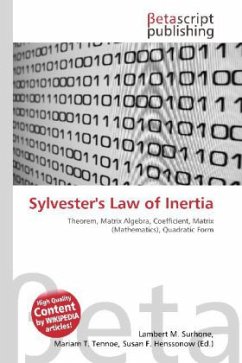
Sylvester's Law of Inertia
Versandkostenfrei!
Versandfertig in 6-10 Tagen
26,99 €
inkl. MwSt.

PAYBACK Punkte
13 °P sammeln!
Please note that the content of this book primarily consists of articles available from Wikipedia or other free sources online. Sylvester''s law of inertia is a theorem in matrix algebra about certain properties of the coefficient matrix of a real quadratic form that remain invariant under a change of coordinates. Namely, if A is the symmetric matrix that defines the quadratic form, and S is any invertible matrix such that D = SAST is diagonal, then the number of negative elements in the diagonal of D is always the same, for all such S; and the same goes for the number of positive elements.Thi...
Please note that the content of this book primarily consists of articles available from Wikipedia or other free sources online. Sylvester''s law of inertia is a theorem in matrix algebra about certain properties of the coefficient matrix of a real quadratic form that remain invariant under a change of coordinates. Namely, if A is the symmetric matrix that defines the quadratic form, and S is any invertible matrix such that D = SAST is diagonal, then the number of negative elements in the diagonal of D is always the same, for all such S; and the same goes for the number of positive elements.This property is named for J. J. Sylvester who published its proof in 1852.Let A be a symmetric square matrix of order n with real entries. Any non-singular matrix S of the same size is said to transform A into another symmetric matrix B = SAST, also of order n, where ST is the transpose of S. If A is the coefficient matrix of some quadratic form of Rn, then B is the matrix for the same form after the change of coordinates defined by S.












